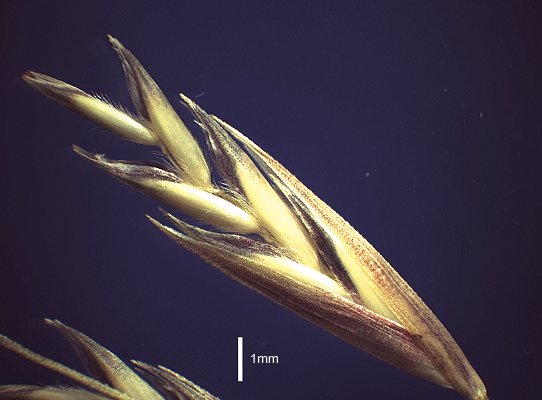Triodia hubbardii N. T. Burbidge. Austral. J. Bot. 8: 381 (1960).
Classification. (GPWG 2001) : Subfamily Chloridoideae. Triodeae.
Type of Basionym or
Protologue Information: Northern Territory: Central Australia; Standley
Chasm, MacDonnell Range, 18.xi.1955., N.T. Burbidge & M. Gray 4153
(HT: CANB; IT: K, L, NSW, NT).
Key references
(books and floras): [1981] M.Lazarides in J.Jessop (ed)., Flora of
Central Australia (445), [2002] D.Sharp & B.K.Simon, AusGrass,
Grasses of Australia.
Habit.
Perennial. Stolons present. Culms 45–160 cm tall. Leaf-sheath auricles absent.
Ligule a fringe of hairs. Leaf-blades ascending or drooping, curved or flexuous,
aciculate, flat or conduplicate, 15–45 cm long, 1–3 mm wide.
Inflorescence.
Inflorescence compound, a panicle of racemes. Panicle elliptic, 25–60 cm long,
3–6 cm wide, contracted about primary branches.
Spikelets.
Spikelets pedicelled. Fertile spikelets many flowered, with at least 2 fertile
florets (5–11), comprising 5–11 fertile floret(s), with diminished florets at
the apex, linear, laterally compressed or terete, 8–20 mm long.
Glumes.
Glumes similar, thinner than fertile lemma. Lower glume lanceolate, membranous
or scarious or cartilaginous, keeled, 1-keeled, 3(–5) -nerved. Lower glume
surface glabrous. Lower glume apex muticous or mucronate. Upper glume
lanceolate, 5–8 mm long, membranous or scarious or cartilaginous, keeled,
1-keeled, 3(–5) -nerved. Upper glume surface scabrous, glabrous. Upper glume
apex with a unilateral tooth or dentate, muticous or mucronate.
Florets.
Fertile lemma 5 mm long, without keel, 9–11 -nerved. Lemma surface indumented.
Lemma apex lobed. Lodicules present. Anthers 3.
Continental
Distribution: Australasia.
Australian
Distribution: Northern Territory.
Northern Territory:
Central Australia North, Central Australia South.
Notes.
Diagnostic characters include the highly resinous leaves; large racemose
panicles; linear spikelets with distant florets; bitextured mostly glabrous and
smooth lemmas and paleas; sparsely hairy 3-lobed 9-nerved lemmas; blunt,
ribbed, laterally bearded callus; flattened, ribbed rachilla internodes. Allied
to T. pungens and T. mitchellii, but differs in the morphology
and indumentum of the spikelets.
Central
Australia, N.T. On skeletal soil on rocky hills and gorges of sandstone,
quartzite and sometimes granite; occasionally in white sandy creek bed near
hills and near inland lakes; flowers Apr., July-Jan.




